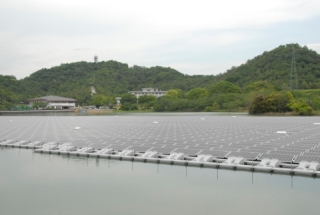May 30 2015
Kyocera Corporation (President: Goro Yamaguchi; herein “Kyocera,”) and Century Tokyo Leasing Corporation (President: Shunichi Asada; herein “Century Tokyo Leasing”) announced today that Kyocera TCL Solar LLC has completed construction of its third floating mega-solar power plant in Hyogo Prefecture, Japan.
 2.3MW floating solar power plant in Kasai City, Hyogo Prefecture (Japan) (Photo: Business Wire)
2.3MW floating solar power plant in Kasai City, Hyogo Prefecture (Japan) (Photo: Business Wire)
A ceremony was held on May 24 to commemorate completion of the 2.3-megawatt (MW) plant, which will generate an estimated total of 2,680 megawatt hours (MWh) per year — enough electricity to power approximately 820 typical households*.
Kyocera and Century Tokyo Leasing jointly established Kyocera TCL Solar LLC in August 2012 for the purpose of constructing and operating multiple solar power plants in Japan. Due to the rapid implementation of solar power, securing tracts of land suitable for utility-scale plants is becoming increasingly difficult in Japan. In order to utilize the country’s abundant water surfaces, Kyocera TCL Solar began installing floating solar power generation systems last year. This marks the third floating installation completed by the company, in addition to 1.7MW and 1.2MW plants which began operation last month at two different sites in Hyogo Prefecture. The company is also developing a 13.4MW installation on a dam reservoir in Chiba Prefecture, Japan.
Through its projects, Kyocera and Century Tokyo Leasing hope to contribute to the expansion of renewable energy and development of a low carbon society.
Project Overview
| Location |
|
Reservoir in Kasai City, Hyogo Prefecture, Japan |
| Operation |
|
Kyocera TCL Solar LLC |
| Output |
|
2.3MW |
| Solar Modules |
|
255-watt Kyocera modules (9,072 modules in total) |
|
Expected annual power
generation
|
|
Approx. 2,680MWh/year
Electricity generated will be sold to the local utility (The Kansai Electric Power Co., Inc.) through Japan’s feed-in-tariff system. |
| Start of operation |
|
June 2015 (planned) |
Features
- Floating solar power generating systems typically generate more electricity than ground-mount and rooftop systems due to the cooling effect of the water.
- The systems reduce reservoir water evaporation and algae growth by shading the water.
- Floating platforms are 100% recyclable, utilizing high-density polyethylene, which can withstand ultraviolet rays and resists corrosion.
- The floating platforms are designed and engineered to withstand extreme physical stress, including typhoon conditions.
* Based on average annual use of 3,254.4kWh per household. Source: Federation of Electric Power Companies of Japan (Graphical Flip-chart of Nuclear & Energy Related Topics 2015)